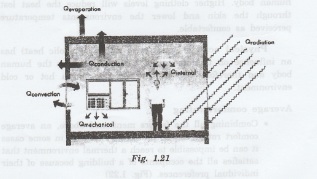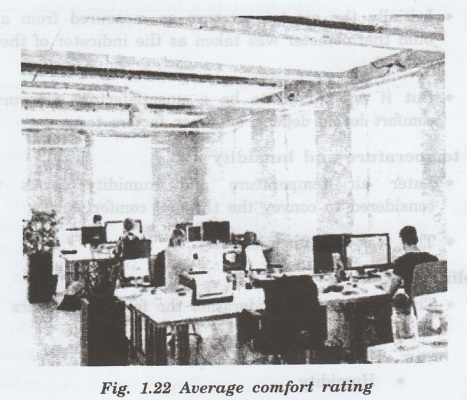Physics For Civil Engineering: Unit I: Thermal Application
Thermal Comfort
Thermal comfort describes the human satisfactory view of the thermal environment. It refers to a number of conditions in which the majority of people feel comfortable.
THERMAL COMFORT
Thermal comfort describes the human
satisfactory view of the thermal environment. It refers to a number of
conditions in which the majority of people feel comfortable.
Thermal comfort is rated amongst the
most important conditions for improving comfort and satisfaction of occupants
with their indoor environment.
Factors
influencing thermal indoor environment
The heat exchange between the human body
and its environment occurs mainly in three ways, namely through: (Fig. 1.20)
•
Radiation
• Convection
• Evaporation
Thermal indoor environment is affected
by both internal and external sources.
Common
heat sources:
• electrical equipment (such as lighting
and computers)
• sun radiation
• human presence

Common sources of cold:
• window surfaces
• poorly insulated walls
•
thermal bridges in the constructions
All these sources will influence the
human perception of the environment and therefore the comfort level. (Fig.
1.21)

Thermal comfort refers to the perceived
feeling on the human body as a result of the effect of heat and cold sources in
the environment.
Factors
that influence thermal comfort
Thermal comfort is mainly influenced by
six variable factors which are needed to maintain a healthy balance in order to
sustain the occupants' satisfaction with their surrounding environment.
Air
temperature, a common component of thermal comfort;
it can easily be influenced with passive and mechanical heating and cooling.
Mean
radiant temperature, the weighted average temperature of
all exposed surfaces in a room.
Air
velocity (or air flow) quantifies the speed and direction of
the air movements in the room. Rapid air velocity fluctuations might result in
draught complaints.
Humidity
(or relative humidity) is the moisture content of the air. Too high or too low
humidity levels may induce discomfort.
Clothing
level, the amount of insulation added to the human body.
Higher clothing levels will reduce the heat lost through the skin and lower the
environments temperature perceived as comfortable.
Physical
activity level (also called metabolic heat) has an
influence on the amount of heat produced by the human body and therefore also
in the perception of a hot or cold environment.
Average comfort rating
• Combining all the factors mentioned
above, an average comfort rating can be predicted. However, in some cases it
can be impossible to reach a thermal environment that satisfies all the
occupants of a building because of their individual preferences. (Fig. 1.22)
In those cases, it's still possible to
specify conditions that are likely to be perceived as acceptable to most. And
if combined with opportunities for individual control (such as bezo change of
clothing or window opening), the overall satisfaction with the environment will
increase considerably.

Thermal comfort affects the work performance
Thermal conditions can affect the
building occupants' productivity and work performance through several
mechanisms. Thermal discomfort can:
• cause attention distraction
• disturb well –being (Heat strokes, Heart diseases,
Dehydration, Cold – Frostbite)
• reduce the ability to concentrate
properly (Decreases both mental and physical performance)
Physics For Civil Engineering: Unit I: Thermal Application : Tag: : - Thermal Comfort
Related Topics
Related Subjects
Physics for Civil Engineering
PH3201 2021 Regulation | 2nd Semester Civil Dept 2021 Regulation
